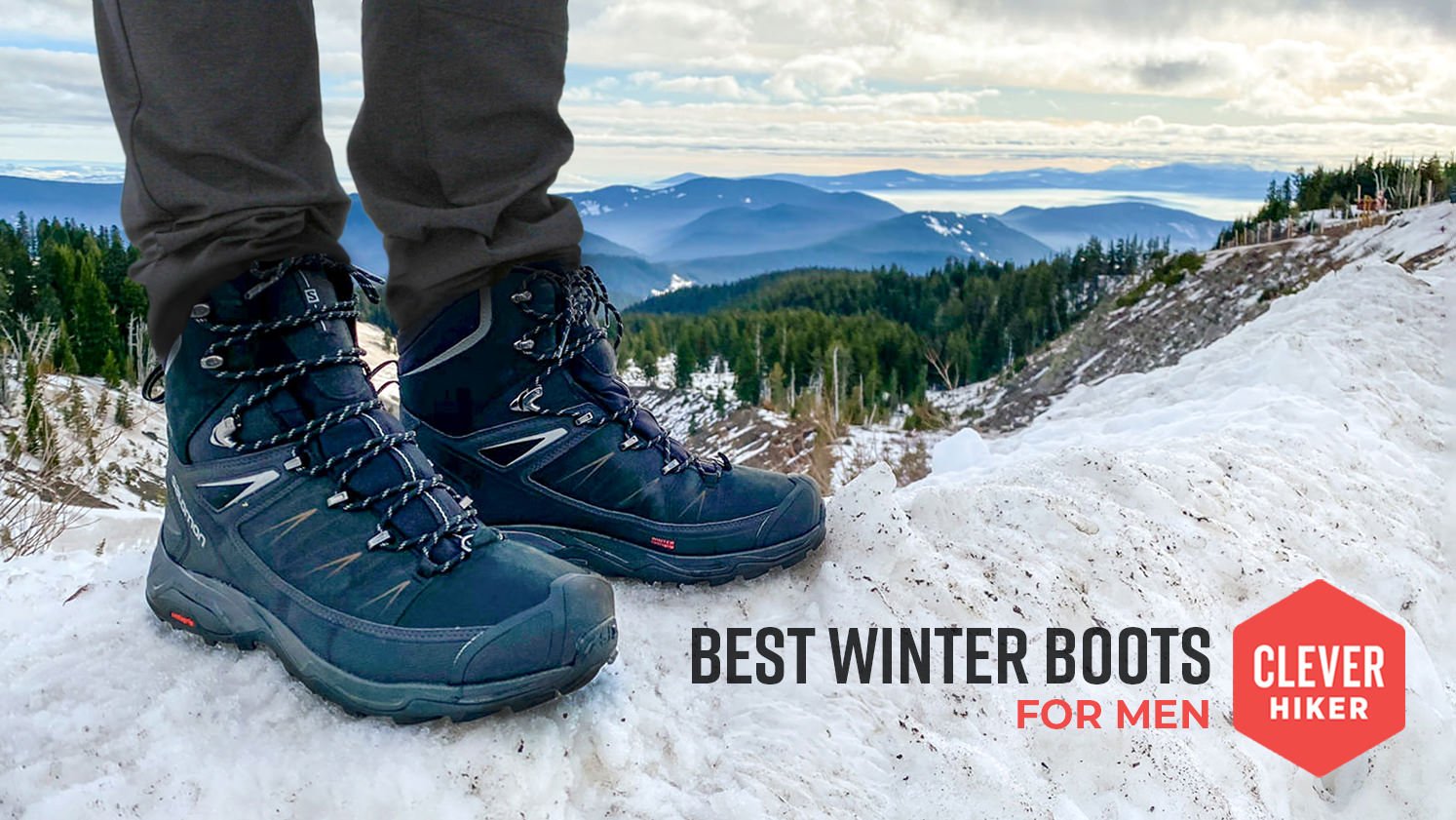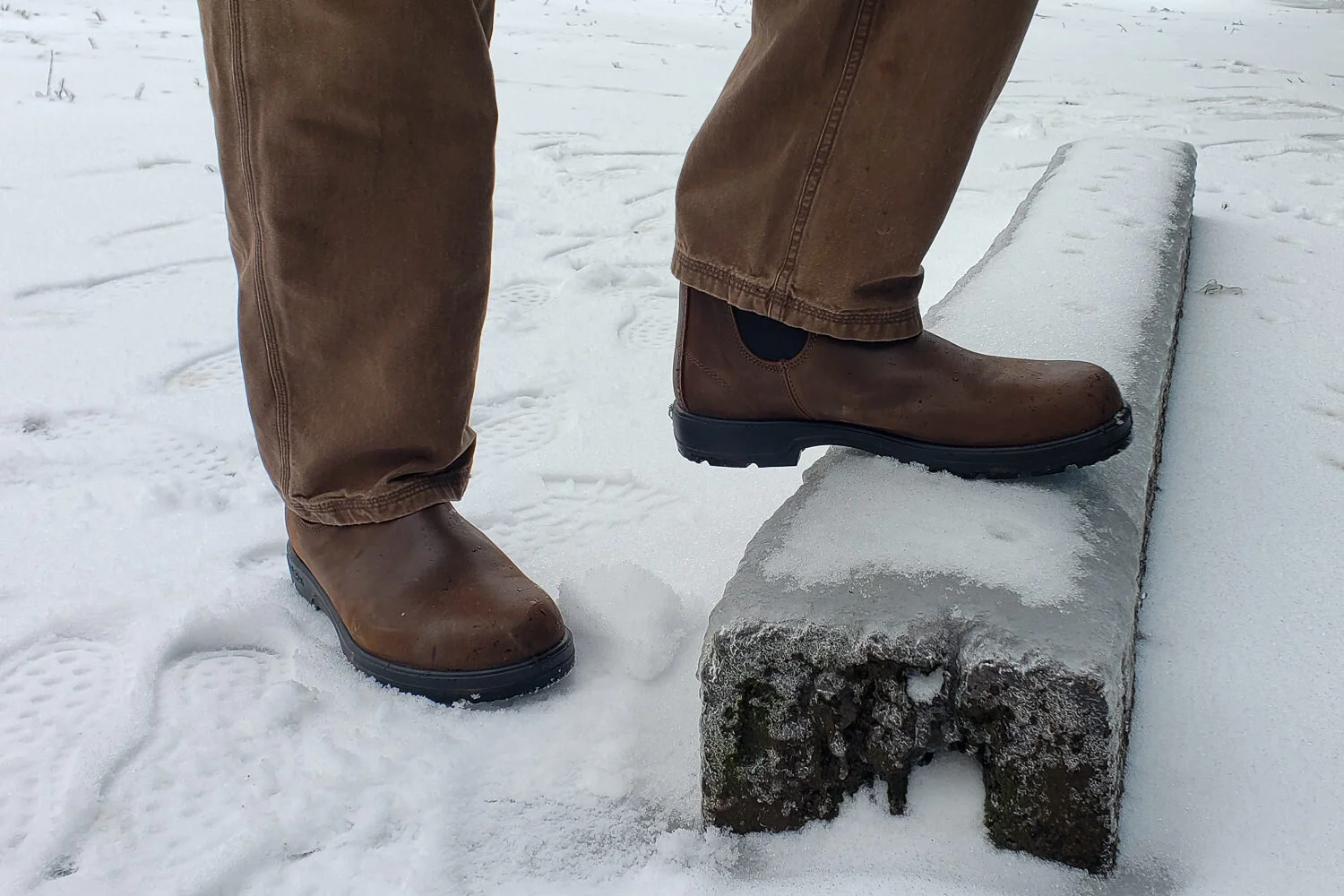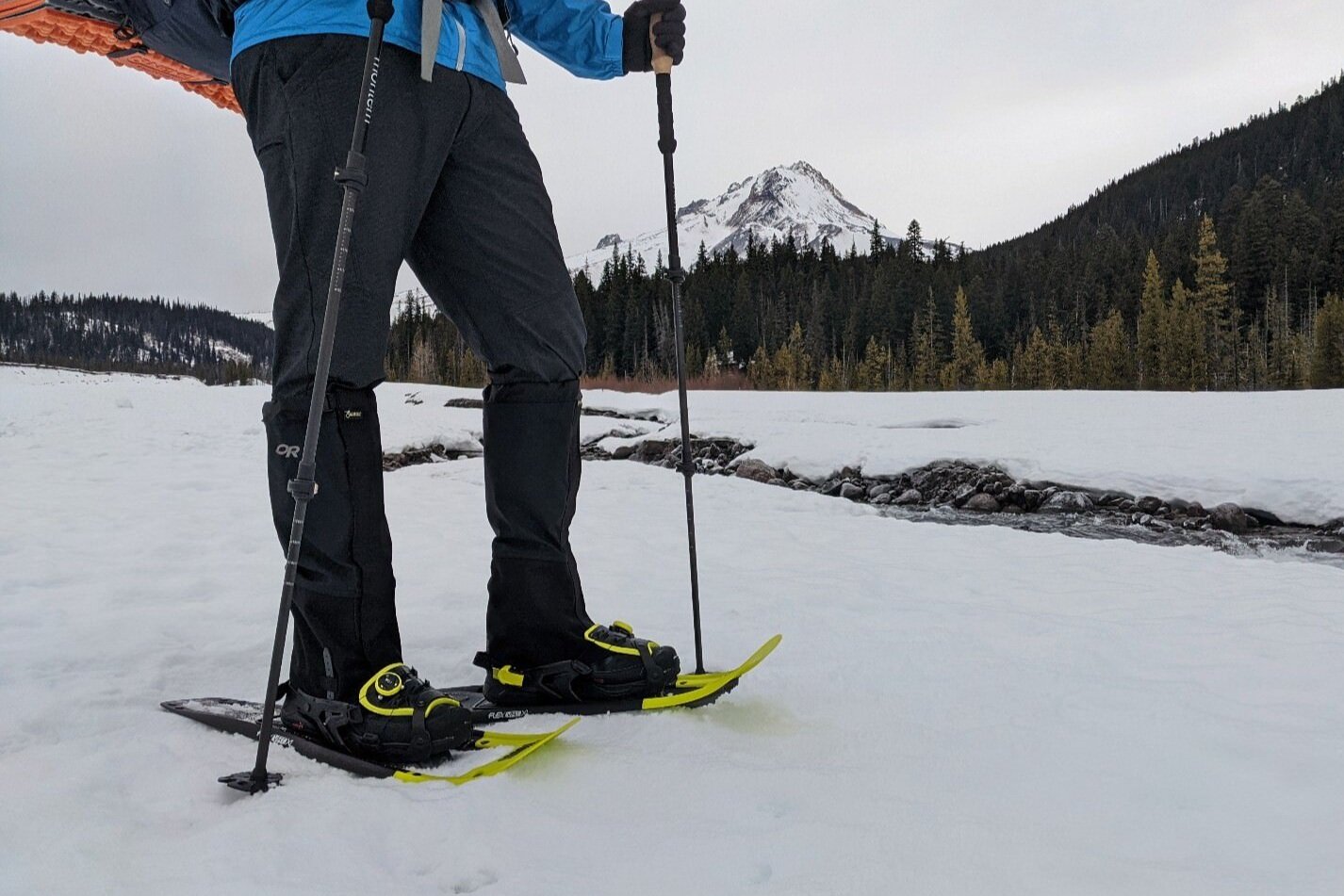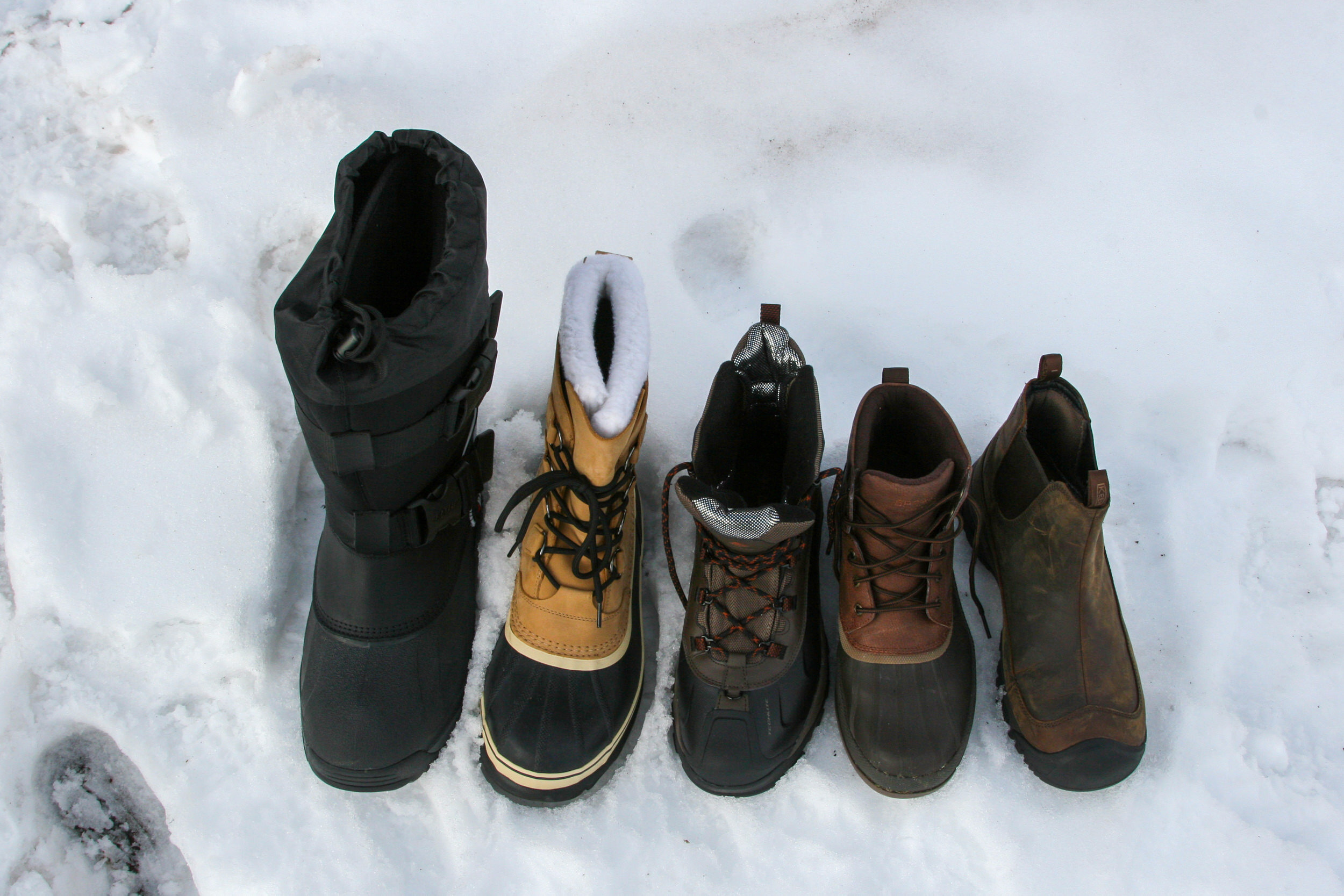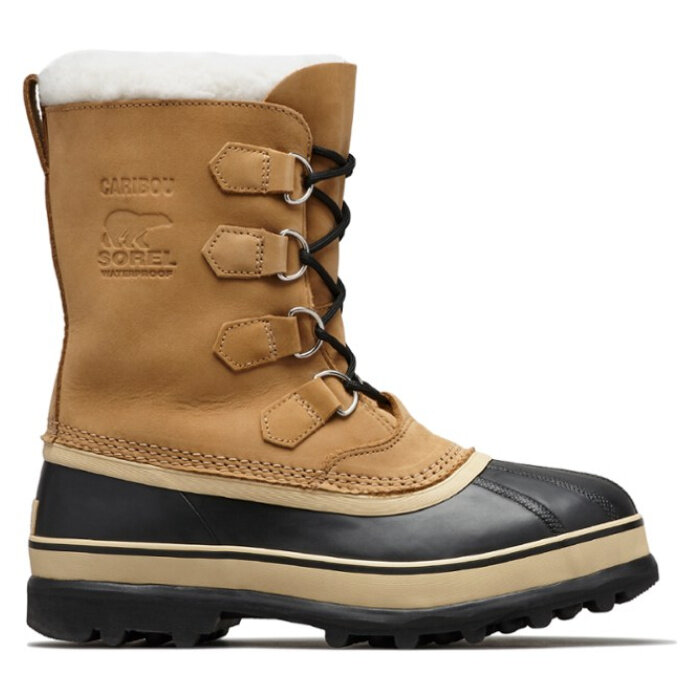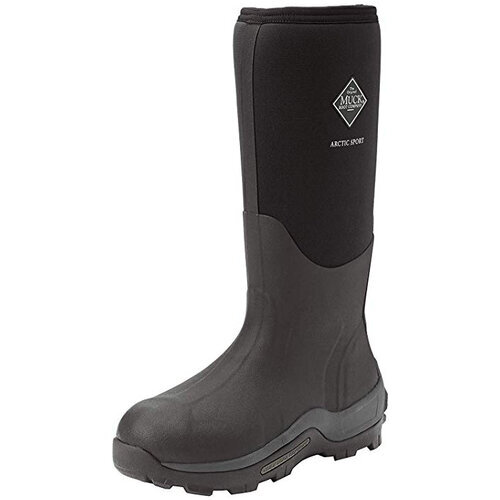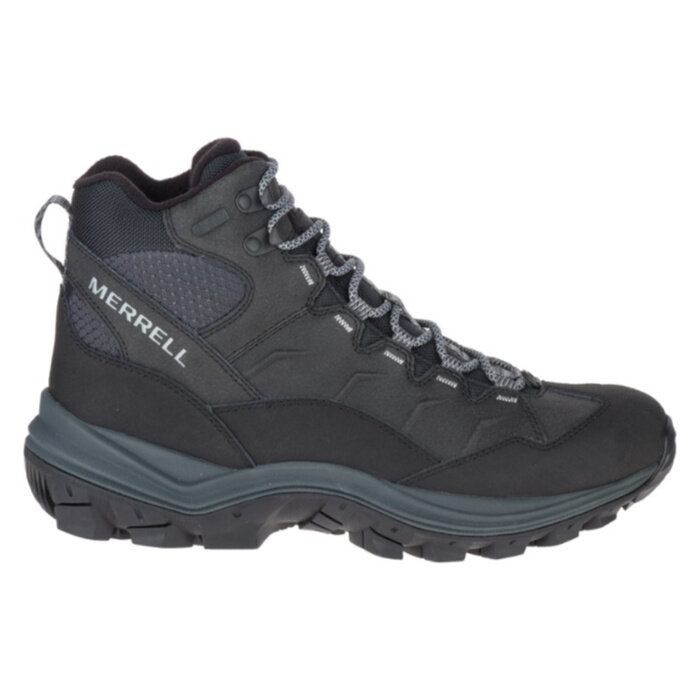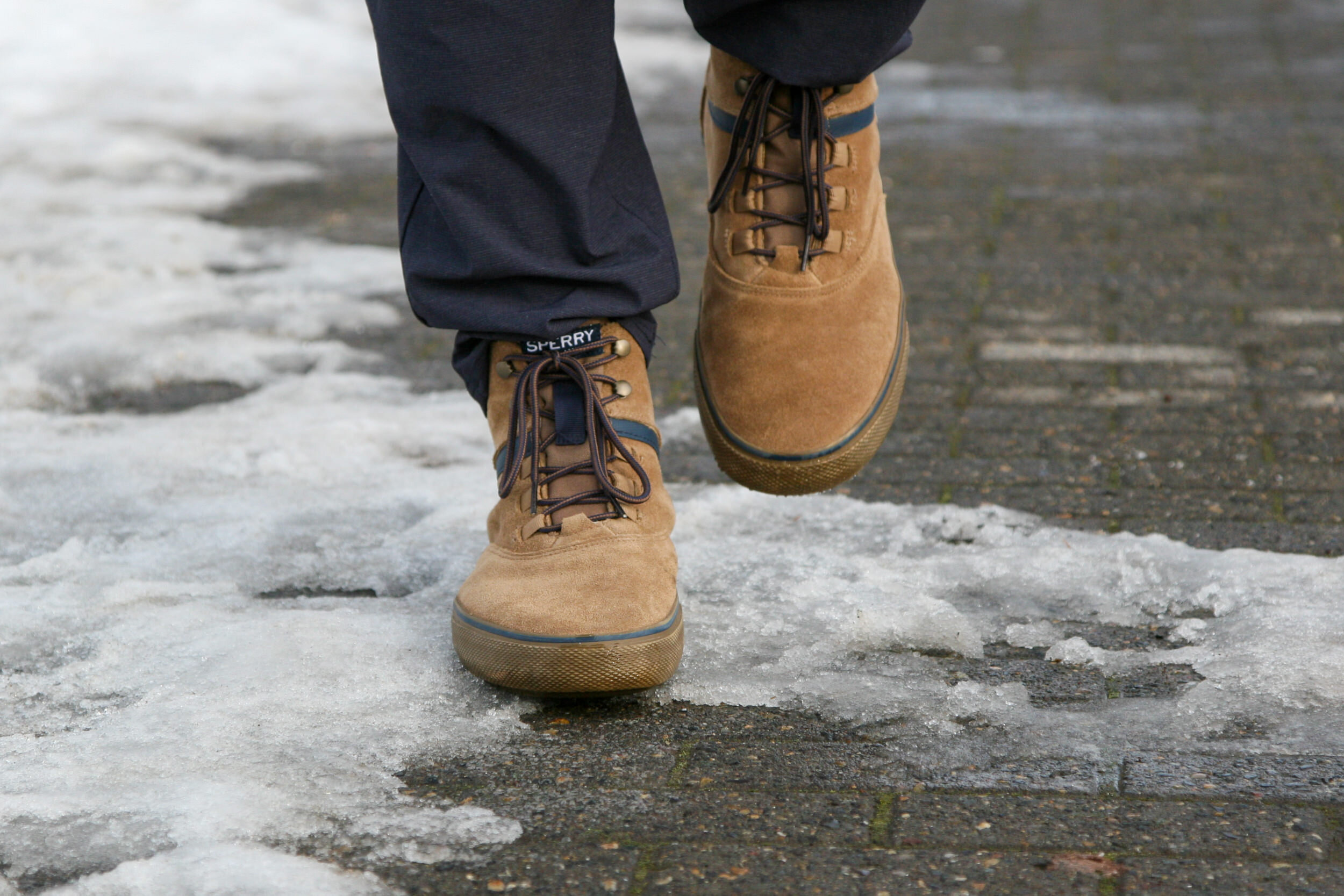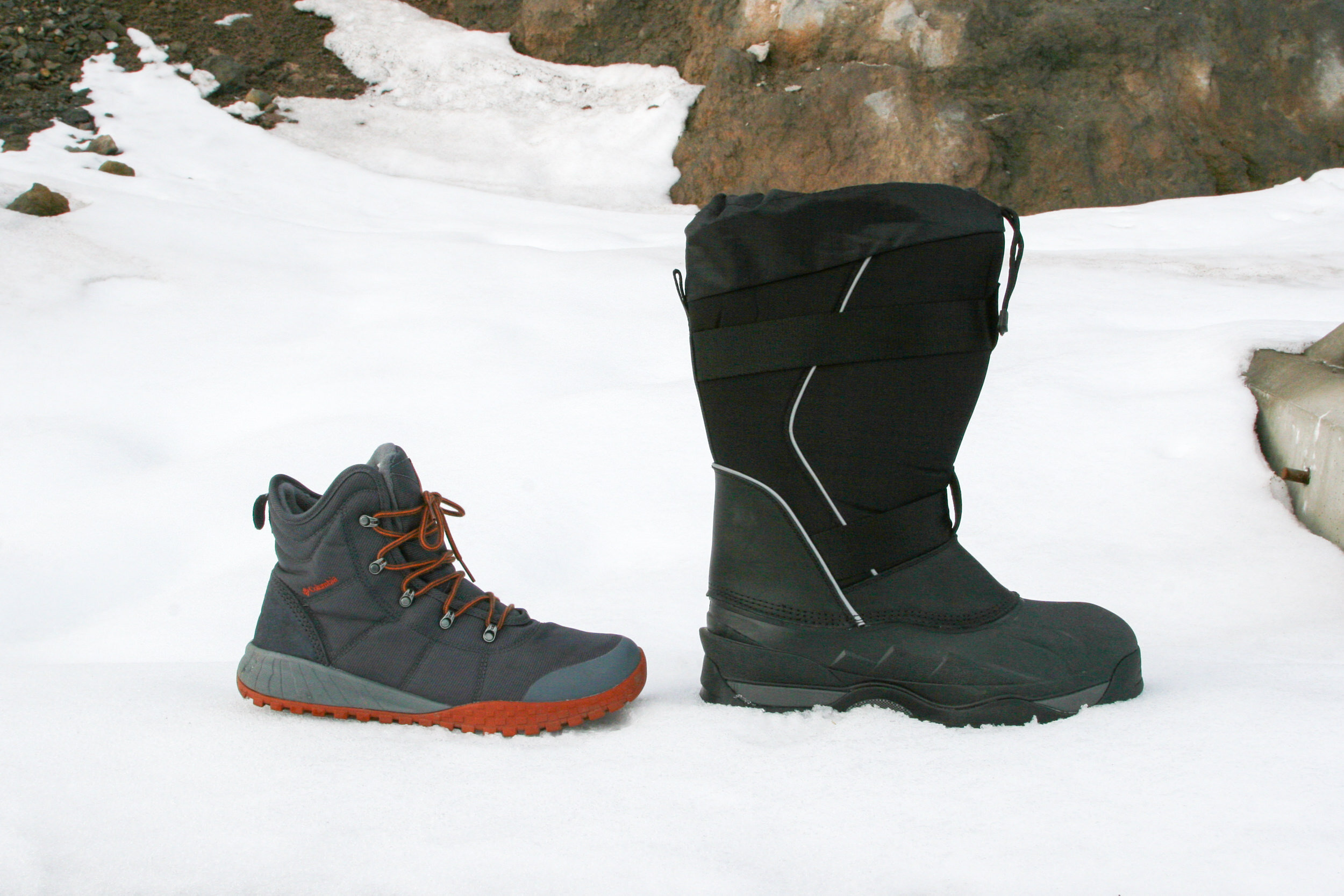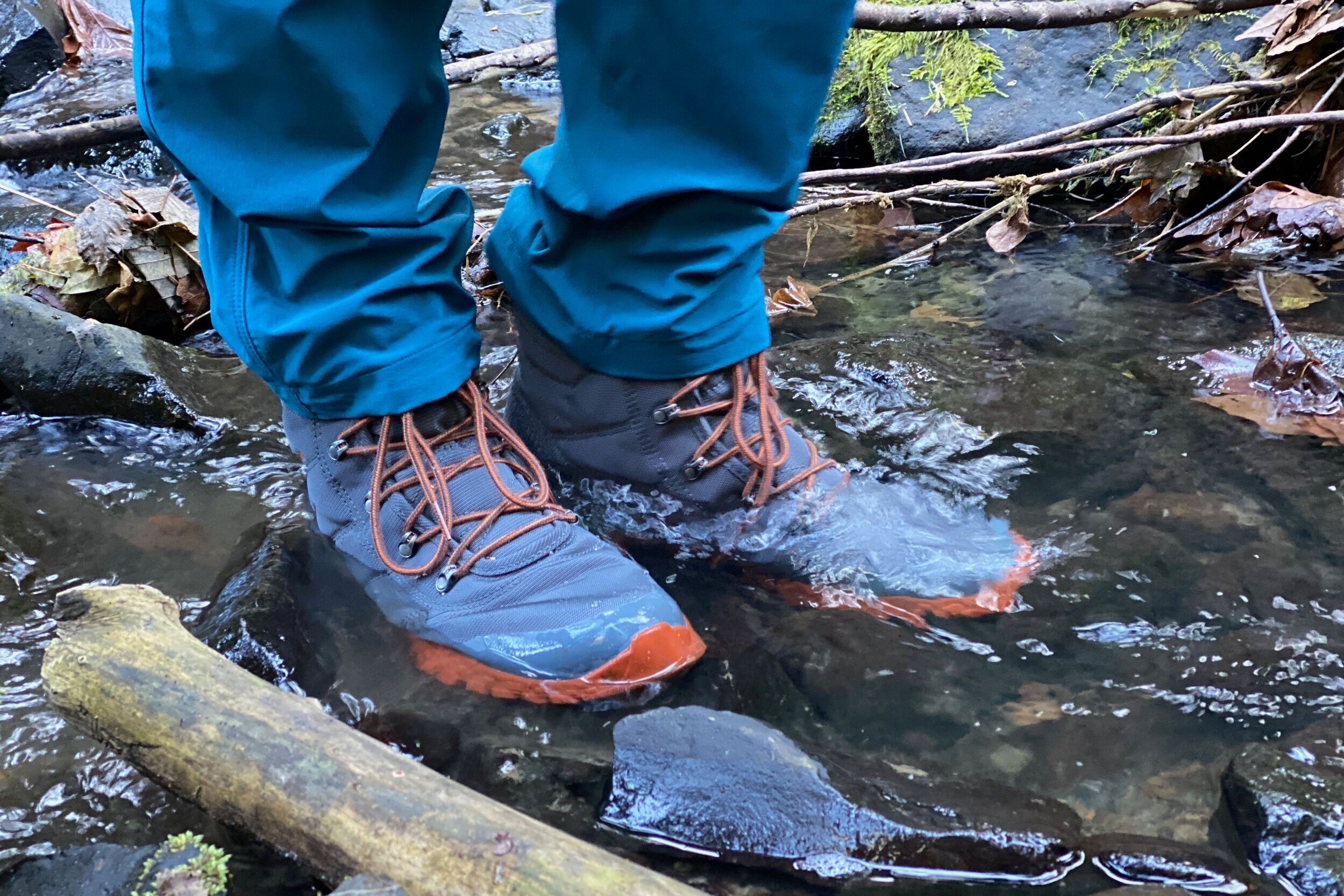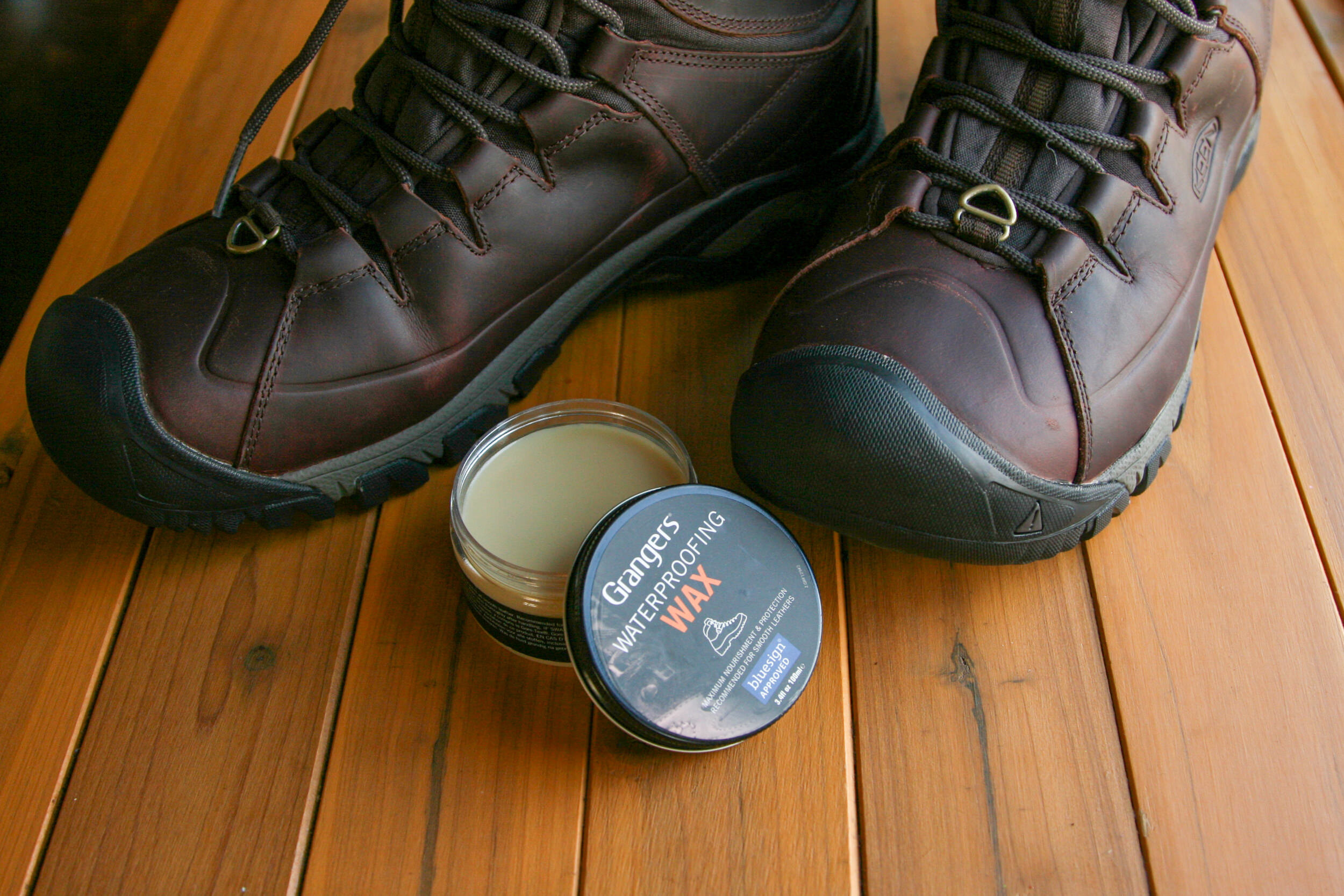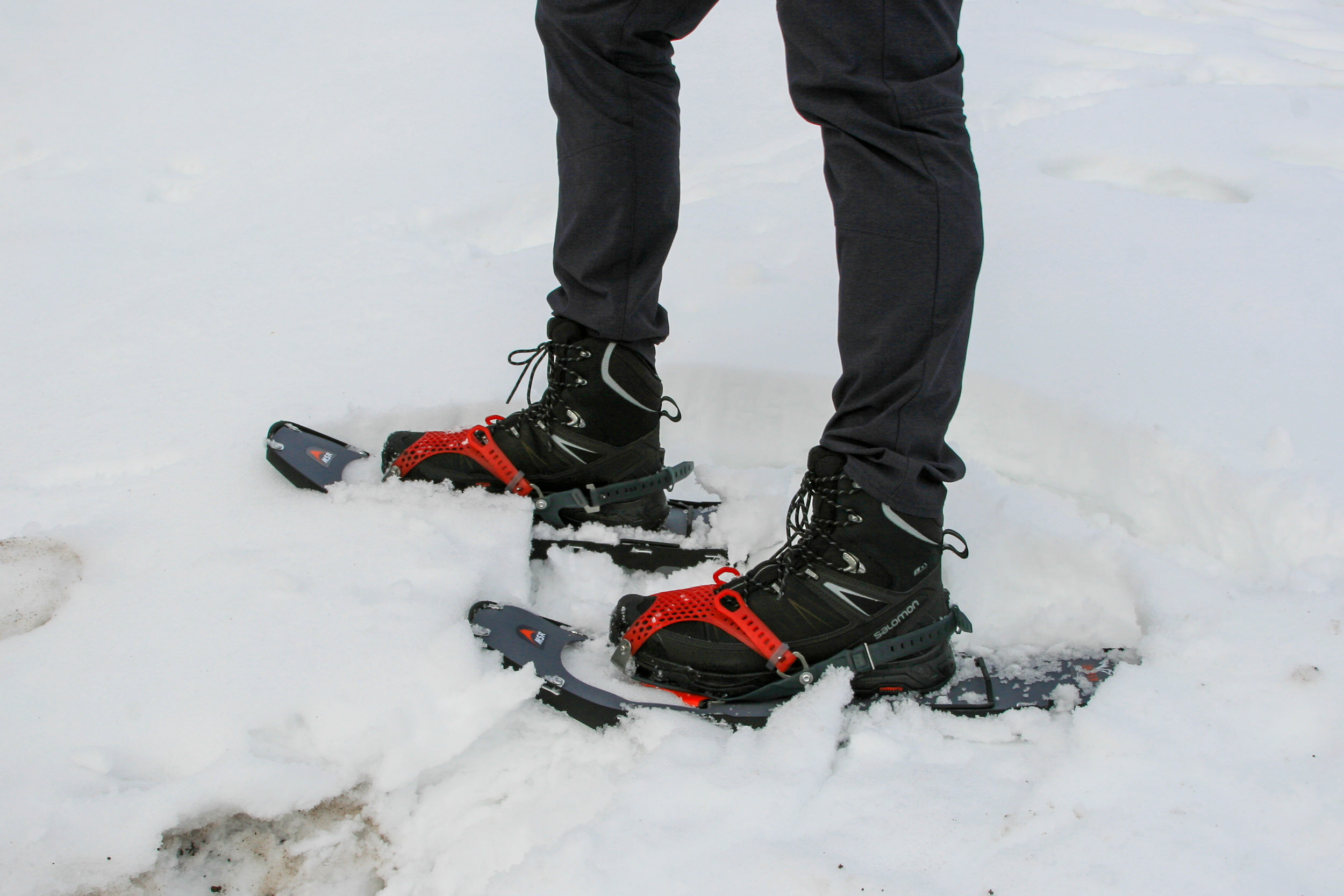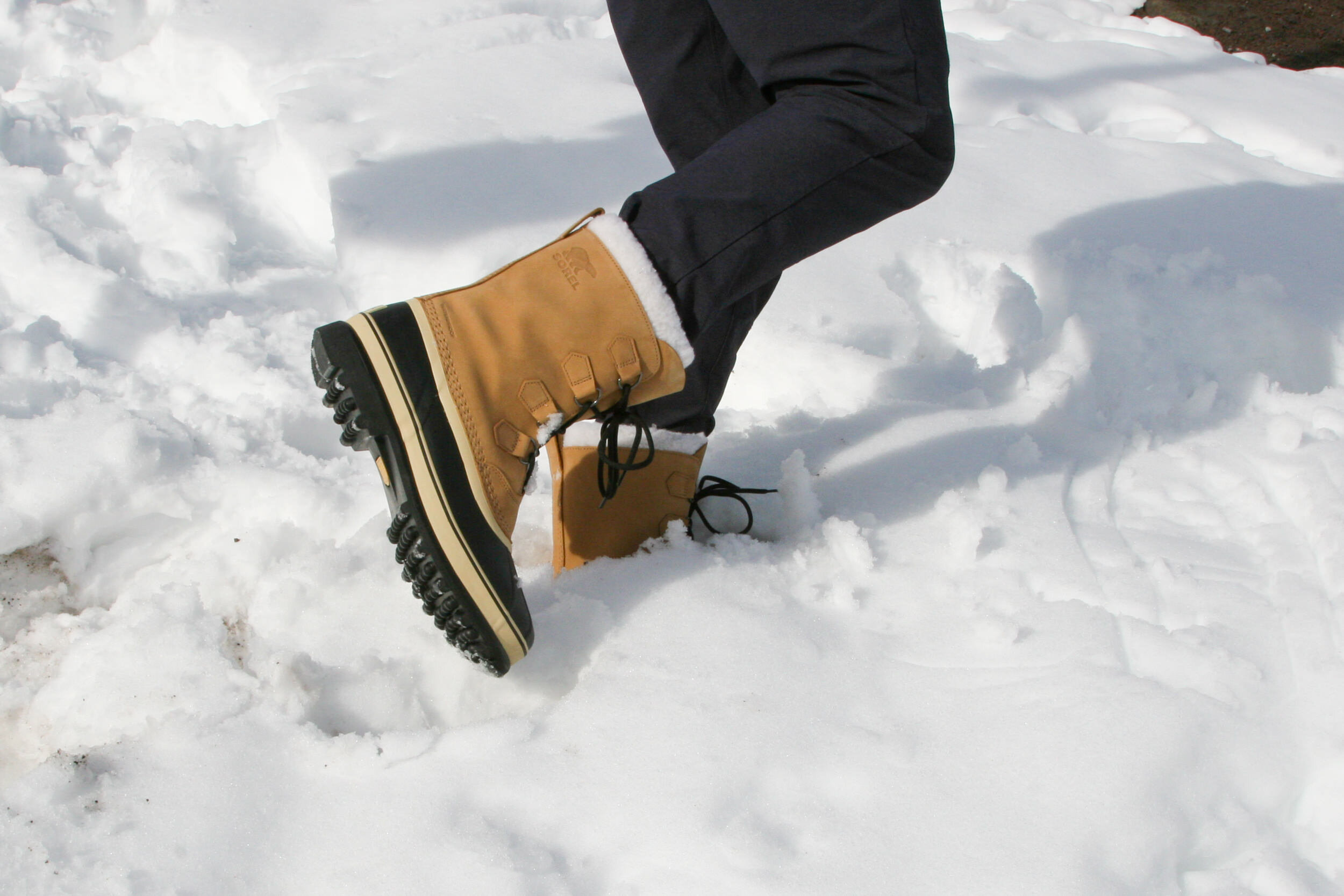Author: Heather Eldridge | Tester & Editor: Dave Collins
Last updated: March 24, 2023
Most of us hate saying goodbye to our sandals and shorts for the winter season, but there’s something alluring about donning a pair of winter boots and layering up to face the weather.
Footwear that keeps you warm and dry will make it much easier to go outside and enjoy some exercise, sunlight, and fresh air when the temperature drops. We put dozens of winter boots to the test on icy streets, snow dusted trails, and powder covered mountains to bring you this list of the very best.
Related: Best Winter Boots for Women
The Salomon X Ultra Mid Winter are the best winter boots for hiking
Quick Recommendations
Check out this quick list of our favorite winter boots, or continue scrolling to see our full list with in-depth reviews.
Best winter boots for hiking: Salomon X Ultra Mid Winter
Best warm snow boots: Sorel Caribou
Best winter boots for wet conditions: Muck Boot Arctic Sport
Best snow boots for extreme cold: Baffin Impact
Best town-to-trail winter boots: Columbia Fairbanks
Best ultralight trail runners for winter: Altra Lone Peak ALL-WTHR Mid 2
Stylish winter boots for around town: Sperry Striper Storm
Supportive winter boots with excellent traction: Merrell Thermo Chill Mid
Rugged winter boots for hiking & snowshoeing: Oboz Bridger 8” BDry Insulated
Leather hiking boots with an extra-wide toe box: KEEN Targhee High Lace
Durable & stylish boots for wet winters: Blundstone Super 550
The Blundstone Super 550 Boots are comfortable, stylish & durable,. Plus they can be worn for multiple seasons
What’s Most Important to You in a Winter Boot?
PRICE - You don’t have to break the bank to get a pair of top-quality winter boots, but we find that spending a little extra is often worth the boost in insulation, traction, and durability.
Best value winter boots: Salomon X Ultra Mid Winter, Sorel Caribou & Muck Boot Arctic Sport
Best budget winter boots: Sperry Striper Storm & Merrell Thermo Chill Mid
Best high-end winter boots: Baffin Impact & Blundstone Super 550
Salomon’s X Ultra Mid Winter are durable, comfy right out of the box & they have excellent traction for hiking
ACTIVITY LEVEL - What will you primarily be using your boots for? Hiking? Working outside? Everyday wear around town? Figuring out what you’ll use your boots for most will help determine how warm they should be. The use will also help you decide how much coverage is ideal and what materials are likely to suit your needs best.
Best winter boots for snowshoeing & hiking: Salomon X Ultra Mid Winter, Columbia Fairbanks, Altra Lone Peak ALL-WTHR Mid 2, Merrell Thermo Chill Mid & Oboz Bridger 8” BDry Insulated
Best winter boots for around town: Sorel Caribou, Sperry Striper Storm, Columbia Fairbanks & Blundstone Super 550
THE Sorel Caribou LINERS COME OUT FOR EASY DRYING
INSULATION - You’ll likely want a lighter, more breathable boot for high-output activities, but your feet should never get really cold in a good pair of winter boots. All boots meant for winter should be at least minimally insulated with materials like fleece, wool, or synthetic fibers to help retain body heat. Uninsulated waterproof boots can also work as long as there’s ample room to wear thick wool socks. For extremely cold weather or low activity levels, medium-heavy insulation may be required to keep your feet warm.
Best lightly-insulated winter boots: Salomon X Ultra Mid Winter, Columbia Fairbanks & Blundstone Super 550 Boots
Best heavily-insulated winter boots: Baffin Impact, Sorel Caribou & Muck Boot Arctic Sport
Most to least insulated from Left to Right - Baffin Impact, Sorel Caribou, Columbia Bugaboot Plus, Sperry Cold Bay Chukka, Keen Anchorage II
BOOT HEIGHT & GAITERS - Taller boots are best for extreme cold and deep snow, though lower-cut ankle boots allow greater movement and are generally more comfortable to walk or hike in. Snow gaiters can be added to any height boot to increase weather protection and keep snow from getting into the top cuff. Some boots have built-in gaiter loops near the toe that you can connect gaiters to increase their effectiveness.
Best tall winter boots: Muck Boot Arctic Sport, Sorel Caribou & Baffin Impact
Best ankle-height winter boots: Salomon X Ultra Mid Winter, Columbia Fairbanks, Altra Lone Peak ALL-WTHR Mid 2 & Merrell Thermo Chill Mid
Snow gaiters can be added to any height boot to increase weather protection & keep snow from getting in the top cuff
TRACTION - The more intense your activity will be and the more extreme the conditions (ice), the more traction you’ll need to keep from slipping, sliding, and potentially falling. For activities like hiking, a boot with aggressive traction is recommended. To increase traction on any boot, traction systems like Kahtoola MICROspikes (for backcountry hiking) or NANOspikes (for use around town) are available.
Winter boots with the best traction: Salomon X Ultra Mid Winter, Sorel Caribou, Oboz Bridger 8” Bdry Insulated & Baffin Impact
We own & use all of the winter boots we recommend
Best Winter Boots of 2023
BEST WINTER BOOTS FOR HIKING
MSRP: $165
TEMP RATING: Not rated
INSULATION: 200 g. Synthetic fiber
WEIGHT (PAIR): 1 lb. 14.8 oz.
SIZING: True to size
PROS: Excellent value, lightweight, excellent traction, warm, comfortable, durable, gaiter hooks, snowshoe compatible
CONS: Need gaiters to keep deep snow out
BOTTOM LINE: Salomon’s X Ultra Mid Winter boot is a fantastic addition to their popular X Ultra line, which we already trust for great 3-season shoes and boots. The X Ultra Winters are equipped with solid midsole support and aggressive tread that’s ideal for active winter adventures like hiking and snowshoeing. They’re comfortable right out of the box, and they’re exceptionally lightweight for how rugged and warm they are. The X Ultras are an excellent value since their quality, comfort, and durability are tough to beat.
BEST WARM SNOW BOOTS
MSRP: $200
TEMP RATING: Not rated
INSULATION: 9 mm. recycled felt
WEIGHT (PAIR): 5 lbs. 1.1 oz.
ALSO AVAILABLE IN: Wool Liner
SIZING: True to size
PROS: Great value, warm, comfortable, durable, excellent traction, removable liner (quick-drying, washable & replaceable)
CONS: Heavy/bulky, loose-fitting (clunky for long walks)
BOTTOM LINE: Sorel’s Caribou Snow Boots are perfect for winter activities like shoveling the driveway or walking around town in snowy conditions. The current model of the Caribous has the same thick felt liners they’ve had for years, but the rubber lug outsoles have been updated to offer more traction than ever before. The Caribous are legendary for their durability too. It’s common for a pair to last for 10 years or more, which makes them an excellent value. You can extend the life of your ‘bous even further by replacing the liners as they get worn as well.
BEST WINTER BOOTS FOR WET CONDITIONS
MSRP: $190
TEMP RATING: -40°F to 40°F
INSULATION: 5 mm. Neoprene
WEIGHT (PAIR): 6 lbs.
ALSO AVAILABLE IN: Sport Mid, Steel Toe
SIZING: True to size
PROS: Good height for splash/muck protection, warm, comfortable, durable, slip-on, easy to clean
CONS: Expensive, heavy/bulky, loose-fitting (clunky for long walks), too warm for normal conditions
BOTTOM LINE: Muck Boot’s Arctic Sport is one of the absolute best winter boots on the market for consistently wet and cold conditions. Like the name suggests, they’re designed specifically for working around mud and standing water. The Arctic Sport has a comfortable stretch-neoprene bootie that hugs the calf and foot to trap heat in and keep the elements out. These boots are less flexible than some rain boots and significantly warmer due to a foam underlay in the midsole, fleece lining, and a thicker rubber base. They may be too hot and heavy for intense activity in mild conditions, but overall the Arctic Sports are exceptionally well-made and are a great option for those who need a serious boot for serious weather.
BEST SNOW BOOTS FOR EXTREME COLD
MSRP: $250
TEMP RATING: -148°F
INSULATION: Synthetic foam
WEIGHT (PAIR): 7 lbs. 6.7 oz.
SIZING: Baffin claims they run small, but we found them to be true to size
PROS: Warm, excellent traction, cinch collar, durable, removable liner (quick-drying, washable & replaceable)
CONS: Expensive, bulky/heavy, lacks breathability, loose-fitting (clunky for long walks)
BOTTOM LINE: Baffin’s Impact boots are an excellent choice for shoveling snow or commuting in extremely cold conditions. If you live in a place that gets super cold and snowy like the Midwest, Alaska, or Canada, an intense boot like the Impact with heavy-duty insulation and exceptional traction is ideal for comfort and safety. The thick foam liners will keep you warm in an arctic blast, and they’re removable so you can dry them or air them out after each use. These boots are built tough and will surely last for years, but Baffin also offers replacement liners to extend the Impact’s life even further. The Impacts are expensive, but they’re often on sale for much less than the MSRP.
BEST TOWN-TO-TRAIL WINTER BOOTS
MSRP: $130
TEMP RATING: -25°F
INSULATION: 200 g. synthetic insulation, Omni-Heat™ reflective lining
WEIGHT (PAIR): 2 lbs. 3.4 oz.
SIZING: Fits a bit tight, we recommend ordering up ½ size
PROS: Warm, lightweight, versatile, not bulky, breathable, comfortable, stylish
CONS: Need gaiters to keep deep snow out, minimal traction
BOTTOM LINE: If you’re looking for a versatile boot you can use for a variety of winter activities, the Columbia Fairbanks Snow Boots are an excellent option. They’re fully waterproof and lightly insulated to keep your feet toasty when you’re active, but they’re also breathable so you won’t overheat. With thick socks, these boots are plenty warm unless the temperature is below freezing or you’re inactive for long periods. The Fairbanks’ best assets are how flexible, lightweight, and relaxed they feel. They aren’t overly stiff or super supportive, so they’re not the best choice for snowshoeing or intense hikes. But they’re comfortable and very well-suited to leisurely hikes in wet, cold conditions and casual use around town.
BEST ULTRALIGHT TRAIL RUNNERS FOR WINTER
MSRP: $190
TEMP RATING: Not rated
INSULATION: Uninsulated
WEIGHT (PAIR): 1 lb. 14 oz.
ALSO AVAILABLE IN: ALL-WTHR Low 2
SIZING: True to size
PROS: Lightweight, breathable, comfortable, not bulky
CONS: Need gaiters to keep deep snow out, need thick socks to be winter ready, not as durable as others
BOTTOM LINE: If you’re a minimalist and are used to wearing ultralight trail runners on your walks, runs, and hikes, you might be lamenting the fact that winter weather is forcing you to consider heavy boots. We’re with you. We like our trail runners too, and fortunately Altra's Lone Peak ALL-WTHR Mids are a great crossover option. They’re still very lightweight and breathable like trail runners, but they offer more coverage and better protection for hiking and backpacking in cold, wet conditions. The Lone Peaks aren’t insulated, so you’ll have to keep moving to keep warm in them, but if you know you’ll be moving fast and carrying a light load, they’re an excellent choice.
STYLISH WINTER BOOTS FOR AROUND TOWN
MSRP: $100
TEMP RATING: Not rated
INSULATION: Synthetic
WEIGHT (PAIR): 2 lbs. 8.4 oz.
SIZING: True to size
PROS: Affordable, stylish, warm, comfortable, lightweight, not bulky
CONS: Minimal traction, need leather treatment periodically
BOTTOM LINE: If you’re mostly needing winter boots for around town and style is a priority, Sperry’s Striper Storm Boots are a great choice for everyday winter wear. These high-top suede sneakers keep your feet warm and dry on commutes in the city, and they don’t feel bulky or look out of place once you get to your indoor destination. The Stripers aren’t heavily insulated, so we recommend wearing thick warm socks with them when the temperature dips. The traction and coverage are sufficient for leisurely activities and everyday wear around town in rain or lightly snowy conditions.
SUPPORTIVE WINTER BOOTS WITH EXCELLENT TRACTION
MSRP: $120
TEMP RATING: Not rated
INSULATION: 200 g. synthetic/micro-fleece lining
WEIGHT (PAIR): 2 lb. 4 oz.
SIZING: Fits a bit tight, we recommend sizing up by ½ size
PROS: Affordable, warm, comfortable, durable, excellent traction, gaiter hooks, snowshoe compatible
CONS: Need gaiters to keep deep snow out, lacks breathability
BOTTOM LINE: Merrell’s Thermo Chill Mid Boots are an excellent choice for cold-weather hikes on muddy or snowy terrain. Firm support in the midsole makes the Thermo Chills sturdy enough to handle a heavy load of winter backpacking gear, but they’re still quite lightweight, which means less strain on your body. We like the fleece lining because it keeps your feet warm but also helps wick sweat away to keep them dry. Overall, the Thermo Chills are a great value and solid performers.
RUGGED WINTER BOOTS FOR HIKING & SNOWSHOEING
MSRP: $200
TEMP RATING: Not rated
INSULATION: 200 g. Thinsulate
WEIGHT (PAIR): 3 lbs. 1.2 oz.
ALSO AVAILABLE IN: 10”
SIZING: True to size
PROS: Excellent traction, warm, comfortable, durable, gaiter hooks, snowshoe compatible
CONS: Expensive, need gaiters to keep deep snow out
BOTTOM LINE: If you want a tough winter boot that can handle just about anything, the Oboz Bridger 8” BDry Insulated is up for the challenge. The Bridgers feature grippy tread, supportive insoles to keep your arches comfortable, and stout midsoles capable of bracing hefty loads. The Bridgers are also snowshoe compatible - they’re warm, waterproof, stable, accept gaiters, and have a stiff rubberized heel and toe that pair well with bindings. Overall, the Oboz Bridgers are solid winter boots for all of your winter adventures, especially hiking and snowshoeing.
LEATHER HIKING BOOTS WITH AN EXTRA-WIDE TOE BOX
MSRP: $190
TEMP RATING: -25°F
INSULATION: 200 g. synthetic
WEIGHT (PAIR): 3 lbs. 9.6 oz.
SIZING: Fits a bit tight, we recommend sizing up by ½ size
PROS: Lightweight, excellent traction, warm, comfortable, durable, gaiter hooks, snowshoe compatible
CONS: Expensive, require break-in to be comfortable, need leather treatment periodically
BOTTOM LINE: If you prefer a roomy toe box, the KEEN Targhee High Lace is a great option for hiking and snowshoeing adventures. It features KEEN’s typical wide, rubber-capped toe for a comfortable fit and excellent protection from toe stubs. This winterized version of KEEN’s Targhee hiking boot and shoe series is insulated, has a waterproof membrane, a taller profile, and traction designed for cold conditions. Like most stout leather boots, the Targhee High Lace requires significant break-in to soften and become comfortable, but the Targhees are a great choice for winter excursions once broken in.
DURABLE & STYLISH BOOTS FOR WET WINTERS
MSRP: $220
TEMP RATING: Not rated
INSULATION: Uninsulated
WEIGHT (PAIR): 2 lb. 8 oz.
ALSO AVAILABLE IN: Thermal
SIZING: Blundstones come in Australian sizes, consult a size chart before buying online
PROS: Stylish, lightweight, versatile, not bulky, comfortable, durable, slip-on
CONS: Expensive, need thick socks to be winter ready, water resistant (Thermal style is fully waterproof), need leather treatment periodically
BOTTOM LINE: The Blundstone Super 550 Boots are stylish and functional year-round. With leather lining, leather uppers, and thick polyurethane outsoles, these boots are built to last for many years. Because they‘re not built with insulation, the Super 550s are great for around town in spring and summer. In fall and winter, you can pair them with warm socks to protect your feet from the cold and wet (use a leather waterproofer for additional protection). Thanks to the elastic sides, these boots are super easy to slip on for a quick jaunt around the block or a big night on the town. If your winter is as wet as ours here in the Pacific Northwest, the Super 550s may just be the perfect around town boot for you.
The Muck Boot Arctic Sport provide ultimate protection in wet, cold conditions
Honorable Mentions
The following winter boots didn’t make our final list, but they’re very popular and they’ve still got a lot of good things going for them. You never know, one of these boots might be your perfect fit:
Sperry Cold Bay Chukkas - practical and stylish boots for everyday use
Kamik Hunter Boots - affordable boot for snow, mud, and muck
Columbia Bugaboot Celsius Plus - a cross between a winter hiking boot and a snow boot
Kamik Greenbay 4 - an affordable snow boot for really cold conditions
Sperry’s Striper Storm Boots are stylish & comfortable for wearing around town in wet, cold conditions
Critical Winter Boot Considerations
WEIGHT - Winter boots can weigh 4-7 lbs., but we prefer styles that keep bulk and weight to a minimum for hiking or casual use. For those of us that are used to wearing trail runners, lightweight boots will feel more familiar, comfortable, and far less clunky on the feet. Lighter footwear also takes less of a toll on your body, is generally less stiff, and is easier to break-in.
The lightweight Columbia Fairbanks Vs. heavyweight Baffin Impact
LINERS - Some boots have removable liners (like the Sorel Caribou) which makes it easy to wash them, dry them out quickly, and replace them as needed. But they can also give the boot a looser, less specific fit. A boot dryer can be helpful for quickly drying out wet/sweaty boots with non-removable liners (like the Salomon X Ultra Mid Winter). A loose fit isn’t really an issue for snow boots you’ll use primarily for shoveling the walk. For boots you’ll be hiking or walking around town in, more close-fitting liners will feel less cumbersome and floppy to walk in.
INSOLES - Upgrading your insoles to cushier, warmer, or more supportive aftermarket ones like Superfeet can improve the fit and comfort of most boots. Just remember that you’ll need a little extra room to accommodate thicker insoles.
Comparing Stock INsoles
WEATHERPROOFING - Rubber, treated leather, or vapor barrier membranes (like Gore-Tex), are typical materials used to weatherproof boots. Always take the time to read reviews about boots that claim to be waterproof, and find out if they require any treatments or maintenance (especially leather). A good winter boot should keep your feet dry since moisture leads to heat loss.
the Columbia Fairbanks are a good waterproof option for winter hiking
BRAND - Sometimes it can pay off to try inexpensive off-brands, but we’ve found that it’s usually worth paying a bit more for the quality and durability of tried-and-true brands that have been around for a long time. Generally, we find that we’re more satisfied with the materials and craftsmanship of products from bigger footwear brands that continually take feedback from their customers to improve their products.
SOREL IS WELL-KNOWN FOR QUALITY - SOREL CARIBOU
Pro Tips
WINTER SOCKS - Breathability is often limited in winter boots since they have to be water-resistant to deal with wet conditions, so it’s extra important to wear quality socks that wick moisture and keep your feet dry. If your boots themselves are really warm, a thin merino wool liner sock might be your best bet for staying comfortable. To supplement less insulated boots, thick cushioned wool socks are great for adding warmth. To learn more about what goes into a quality sock and to see some of our top picks, check out our Best Hiking Socks List.
Thorlos Outdoor Fanatic & DARN TOUGH BOOT CUSHION HIKING SOCKS pair well with WINTER BOOTS
WARMING UP - When you first head out the door, it’s important to remember that your boots don’t produce the warmth, your body does. Walking quickly or doing a bit of vigorous exercise to get your blood flowing will help warm up your body and your boots. Good winter boots simply help you retain that heat. You can also support your circulatory system by doing things like getting a good night’s sleep, eating a hearty breakfast, and hydrating to help you stay warm on winter adventures. It also helps a lot to keep your boots inside so they start out at room temperature instead of cold.
Light or Medium-Cushioned Merino wool Socks are a good choice to pair with the Keen Targhee High Lace Boots
TURN UP THE HEAT - When the weather gets really cold, you can easily boost warmth by adding thick socks or Lambswool insoles to your boots to insulate your feet. Just remember to check the size chart and buy your boots in a size that’s loose enough to accommodate thick socks without restricting your circulation. Boots that are too tight will make your feet cold by inhibiting blood flow.
BACOPHY SHEEPSKIN FLEECE INSOLES ADD WARMTH & CUSHION TO ANY BOOTS OR SHOES - just make sure to size up to accommodate the extra thickness
LEATHER BOOT MAINTENANCE - Most leather boots come pre-treated, but some require an aftermarket spray, wax, or polish to make them water-resistant. Almost all leather boots will eventually require some kind of treatment to maintain their weatherproofing. It’s important to pay attention to the type of leather when choosing a product to avoid negatively affecting the appearance, breathability, or integrity of your boots.
Natural oil-based products, like NeatsFoot Oil, are good for adding repellency to smooth leather. They’ll also soften the boots up which helps break them in quicker, but it can lessen their durability.
A wax-based product, like SnoSeal, can easily be applied to specific areas like seams.
For darker leather, Granger’s Waterproofing Wax is an excellent choice that doesn’t clog the pores of leather or Gore-Tex.
Aerosol sprays, like Ariat Water and Stain Protectant, are easy to apply but don’t last as long so you’ll need to treat your boots several times per season. Sprays are best for suede, sheepskin, or nubuck (sanded leather).
GRANGER’S WATERPROOFING WAX IS GREAT FOR MAINTAINING DARKER SMOOTH LEATHER BOOTS
ARE THESE BOOTS GOOD FOR SNOWSHOEING? - Snowshoeing is an excellent way to have some fun and get a great workout during the winter months. Most winter hiking boots that are warm and waterproof will work fine with snowshoes, but there are a few things that make some boots more compatible with snowshoes than others. Check out our list of the Best Snowshoes to see our favorites.
To work well with snowshoe bindings, look for these features:
Moderately stiff sole - won’t buckle too much and allow binding to loosen/slip off
Firm toe - often capped with rubber, should be stiff and hold its shape under pressure
Ridge at heel - helps keep the binding strap securely in place
Gaiter hooks/gap under the arch - allows gaiters to be securely attached to boots
Aggressive traction - keeps the boots more secure in the bindings
Good fit/secure lacing system - doesn’t allow boots to twist or flop around too much with movement
Salomon’s X Ultra Mid Winter Boots ARE an EXCELLENT choice FOR SNOWSHOEING
Need More Gear Advice?
If you liked this list, you’ll love the CleverHiker Gear Guide where we test and recommend tons of outdoor adventure gear from a variety of categories. here are some links to popular articles:
COMPARING TREAD (LEFT TO RIGHT) - Sperry Striper Storm, Merrell Thermo CHill Mid, Sorel Caribou, Oboz Bridger 8” BDRY
Why Trust Us?
We fully understand how tough it is to find trustworthy gear advice, and that’s one of the main reasons we built CleverHiker. We live for outdoor adventure, and we take these guides very seriously. Here are some of the reasons you can trust us:
Our choices are completely independent and based on personal experience.
We’ve logged over 10,000 trail miles and test outdoor gear for a living.
We own and field test every product we recommend, which is sadly not the norm.
We travel to industry trade shows to learn about upcoming product innovations.
We constantly update our guides when new products launch.
We treat our recommendations as if they were for our family and friends.
We’re lifelong learners and we’re always open to constructive criticism. If you think we’ve missed a product or got something wrong, we’d love to hear your feedback.
The Sorel Caribou have a tall cuff to keep snow out when walking in deep drifts
More Information
We hope this guide helps you find the perfect gear for your needs. If you have more questions or a suggestion, we’d love to hear from you! Sign up for our newsletter to stay updated on our latest posts then visit our Facebook page and Instagram to join the community conversation.
If you found this guide helpful, please share on social media and click the little heart button below to give us a digital high five! Also, be sure to check out our CleverHiker Gear Guide to see all of our top gear picks.
Thanks for reading and happy trails!
Some of the links on this page are affiliate links, which means we may receive a modest commission if purchases are made through those links. This adds no cost to our readers and helps us keep our site up and running. Our reputation is our most important asset, which is why we only provide completely honest and unbiased recommendations.

